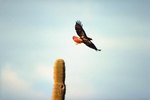In early spring, red-tailed hawks take to the sky to begin their annual mating rituals which include elaborate courtship displays and acrobatic flights. They mate for life, but when one of the pair dies it is quickly replaced. The red-tailed hawk is found throughout North America and is one of the country's most common and easily identified hawks. The birds are mature and begin mating at two years of age.
Courtship
Red-tailed hawks begin their courtship flights by circling slowly at heights of 1,000 feet or more. The male approaches the female from above, touching her briefly. This sets off a series of tumbles and dives at speeds of nearly 100 miles per hour. They may lock bills or talons, and the male may pass food to the female. When the female touches down on a perch the male spirals down to join her and mating takes place.
Nest-Building
Red-tailed hawks prefer to nest near the crown of a tall tree on the edge of a forest, but may also nest on the edge cliff or in rock holes. The pair works together using half-inch diameter sticks about 2-feet long to build a solid but loosely constructed nest. Nests measure 24 to 30 inches in diameter with a 4- to 5-inch depression in the center. Once the structure complete, they line it with grasses, vines and any other soft material they find nearby.
Eggs
Females lay 1 to 3 eggs that hatch in 28 to 32 days. Incubation is primarily the female's responsibility, but the male helps now and then. While the female incubates the eggs the male brings her food, and during warm weather she may leave the eggs to hunt. Both male and female red-tailed hawks defend the nest aggressively.
Nurturing Young
Newly hatched red-tailed hawks are completely helpless, often unable to lift their heads for several hours. For the first four weeks, the parents feed the young hawks, called hawklets. The male brings the food to the nest and the female does the actual feeding. At five weeks a hawklet can tear up and eat animals brought to the nest and at seven weeks they begin to fledge. Once they fledge, the parents largely ignore them, leaving them to learn hunting skills on their own.
References
Photo Credits
-
Jupiterimages/Photos.com/Getty Images
Writer Bio
Jackie Carroll has been a freelance writer since 1995. Her home-and-garden and nature articles have appeared in "Birds & Blooms" and "Alamance Today." She holds a Bachelor of Science in medical technology from the University of North Carolina.




